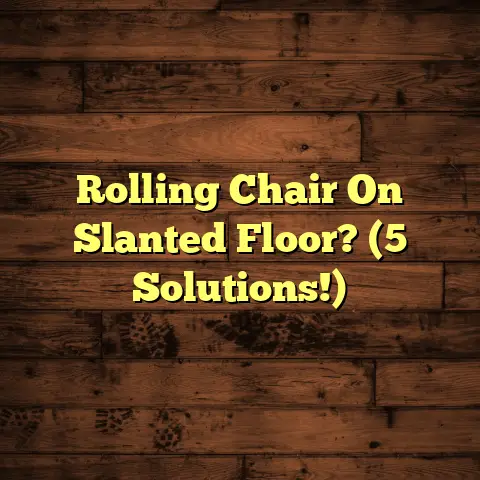How To Lighten Floors? (5 Shade Secrets!)
Imagine stepping into a room where the sunlight dances effortlessly across the floor, illuminating every corner and creating a warm, inviting atmosphere.
The walls are adorned with soft, neutral tones, and the furnishings are carefully selected to complement the space.
But what draws your eye the most is the floor—a stunning, lightened surface that not only enhances the overall aesthetic but also makes the room feel larger and more open.
Whether it’s a cozy living area, a sleek kitchen, or a serene bedroom, the flooring plays a pivotal role in transforming an ordinary space into an extraordinary one.
As a flooring contractor with years of experience, I’ve seen firsthand how dramatically lightening floors can transform a space.
In this article, we will delve deep into the art and science of lightening floors.
We will explore five shade secrets that can dramatically alter the look and feel of your home.
From understanding the psychology of color to practical DIY techniques, this comprehensive guide will equip you with the knowledge and inspiration to achieve that airy, sunlit ambiance you’ve always desired.
Section 1: The Psychology of Color in Flooring
Have you ever walked into a room and instantly felt a certain way?
Color plays a huge role in that!
Colors influence our mood and perception in a space more than you might think.
Think about it: a bright yellow room might feel energetic, while a dark blue room might feel calming.
Light colors, especially in flooring, can create an illusion of space.
They reflect light, making a room feel larger and more open.
Dark floors, on the other hand, tend to absorb light, which can make a room feel smaller and cozier.
Color theory is a whole field dedicated to understanding how colors interact with each other and how they affect us.
It’s super relevant when choosing flooring.
For example, cool colors like light gray or pale blue can create a sense of calm and tranquility.
Warm colors like beige or light oak can make a room feel more inviting and comfortable.
The emotional impact of lighter tones is often associated with feelings of cleanliness, spaciousness, and optimism.
I’ve seen clients who were initially hesitant about light floors completely change their minds once they experienced the difference it made in their home’s atmosphere.
It’s not just about aesthetics; it’s about how the color makes you feel.
Section 2: Selecting the Right Light Shade for Your Floor
So, you’re thinking about going lighter? Great choice!
But with so many options, how do you pick the right light shade?
Let’s dive into the different light shades available for various flooring materials.
Wood:
- White: Crisp, clean, and modern. But can show dirt easily.
- Beige: Warm, neutral, and versatile. Hides imperfections well.
- Light Gray: Contemporary, cool, and sophisticated. Complements many decor styles.
- Light Oak: Classic, natural, and inviting. A timeless choice.
Laminate:
Laminate offers a huge range of light shades, often mimicking the look of wood or tile.
You can find virtually any light shade you desire, from bright white to subtle off-whites.
Tile:
- White: Similar to wood, offers a clean, modern look.
- Light Gray: A popular choice for bathrooms and kitchens.
- Pastel Colors: Soft and subtle, perfect for creating a calming atmosphere.
The nuances between these shades are important.
White can feel stark in some settings, while off-white or cream can feel warmer and more inviting.
Light gray can lean cool or warm depending on the undertones.
Pro Tip: Always get samples and see how they look in your space with your lighting.
Different materials reflect light differently.
For example, a glossy tile will reflect more light than a matte wood floor.
This affects the perceived brightness of the floor.
A study by the American Society of Interior Designers found that rooms with light-reflective flooring appear up to 10% larger than those with dark, light-absorbing floors.
Choosing a shade that complements your existing decor and furnishings is crucial.
Consider the colors of your walls, furniture, and accessories.
Do you want a cohesive, monochromatic look, or do you prefer a contrast?
For instance, light gray floors pair well with bold, colorful accents, while beige floors work beautifully with natural, earthy tones.
Section 3: Techniques for Lightening Existing Floors
Alright, let’s get practical. You’ve got existing floors you want to lighten.
What are your options?
I’ll walk you through several methods, from DIY to professional.
Refinishing Hardwood Floors
This is a classic method for bringing life back to tired hardwood.
Here’s the basic process:
- Sanding: This removes the old finish and any imperfections.
You’ll need a drum sander and an edge sander.
Wear a mask! - Staining: Choose your desired light stain. Apply evenly and wipe off the excess.
- Sealing: Apply several coats of polyurethane or another protective finish.
This protects the wood and adds sheen.
Safety First: Sanding creates a lot of dust.
Seal off the room and wear proper respiratory protection.
Painting Laminate or Tile Floors
Yes, you can paint laminate or tile!
It’s a budget-friendly way to lighten them up.
Here’s how:
- Prep: Clean the floor thoroughly and sand lightly to create a slightly rough surface for the paint to adhere to.
- Prime: Apply a high-quality primer specifically designed for laminate or tile.
This is crucial for adhesion. - Paint: Use a durable floor paint in your chosen light shade.
Apply several thin coats, allowing each to dry completely. - Seal: Seal with a clear polyurethane designed for floors.
Important: Painting floors is not as durable as other methods.
Expect to touch up the paint periodically.
Applying a Whitewash Technique
Whitewashing is a great way to achieve a lighter, rustic look on wood floors.
It allows the natural grain of the wood to show through.
Here’s the process:
- Prepare: Lightly sand the wood floor.
- Mix: Dilute white paint with water (about 1:1 ratio).
- Apply: Brush the mixture onto the floor and immediately wipe off the excess with a clean cloth.
- Seal: Seal with a clear matte finish.
Tip: Experiment with the paint-to-water ratio to achieve your desired level of transparency.
Using Light-Colored Area Rugs
This is the easiest and most non-permanent way to brighten up dark floors.
Strategically placing light-colored area rugs can instantly lighten a room.
Choose rugs in shades of white, beige, light gray, or pastel colors.
Consider rugs with textures or patterns to add visual interest.
DIY Chalk Paint Options
Chalk paint is a versatile option for lightening floors.
It’s easy to apply and creates a matte, chalky finish.
Here’s how to use it:
- Clean: Clean the floor thoroughly.
- Paint: Apply several coats of chalk paint in your chosen light shade.
- Seal: Seal with a clear wax or sealant specifically designed for chalk paint.
Note: Chalk paint is less durable than traditional floor paint, so it’s best suited for low-traffic areas.
Section 4: Choosing the Right Finish to Enhance Lightness
The finish you choose for your lightened floors can significantly impact their overall look and feel.
It’s not just about aesthetics; it’s about durability and maintenance too.
Let’s explore the different types of finishes available and how they affect the perception of lightness.
Types of Finishes:
- Polyurethane: A durable and water-resistant finish, available in oil-based and water-based formulas.
- Varnish: A solvent-based finish that provides a hard, protective coating.
- Lacquer: A fast-drying finish that creates a smooth, glossy surface.
- Wax: A natural finish that provides a soft, matte sheen.
- Oil: Penetrates the wood and enhances its natural beauty.
Gloss Levels:
- Matte: Absorbs light and creates a soft, natural look. Hides imperfections well.
- Satin: Offers a subtle sheen and is easy to clean.
- Semi-Gloss: Reflects more light than satin and is more durable.
- Glossy: Highly reflective and creates a dramatic, modern look. Shows imperfections easily.
Think about your lifestyle.
If you have kids or pets, a more durable finish like polyurethane is a good choice.
Gloss levels significantly affect the perception of lightness.
Glossy finishes reflect more light, making the floor appear brighter.
However, they also show scratches and imperfections more easily.
Matte finishes absorb light, creating a softer, more subdued look.
They are better at hiding imperfections but may not make the floor appear as bright.
For example, a light gray floor with a glossy finish will appear brighter and more modern than the same floor with a matte finish.
However, the glossy finish will require more frequent cleaning to maintain its shine.
The durability and maintenance of various finishes on lightened surfaces are also important considerations.
Polyurethane is highly durable and water-resistant, making it a good choice for high-traffic areas.
Wax finishes require regular maintenance to maintain their protective qualities.
Consider the overall aesthetic you’re trying to achieve.
Do you want a sleek, modern look or a more rustic, natural feel?
The finish you choose should complement your overall design scheme.
Section 5: Maintaining and Caring for Lightened Floors
You’ve lightened your floors – fantastic!
Now, how do you keep them looking fresh and new?
Maintaining light floors requires a bit more attention than darker ones, but it’s totally manageable.
Regular Cleaning:
- Sweep or vacuum regularly: This prevents dirt and debris from scratching the surface.
- Mop with a pH-neutral cleaner: Avoid harsh chemicals that can damage the finish.
- Use microfiber mops: They’re gentle and effective at removing dirt and grime.
Avoid abrasive cleaners.
They can scratch and dull the finish of your lightened floors.
Handling Scuffs, Stains, and Wear-and-Tear:
- Scuffs: Use a magic eraser or a damp cloth with a mild cleaner.
- Stains: Blot the stain immediately with a clean cloth.
Use a stain remover specifically designed for your floor type. - Wear-and-tear: Consider applying a fresh coat of finish every few years to protect the surface.
Pro Tip: Place mats at entryways to trap dirt and prevent it from being tracked onto your floors.
Preventative Measures:
- Use furniture pads: Protect your floors from scratches caused by furniture.
- Avoid wearing shoes indoors: This reduces the amount of dirt and debris that gets tracked onto your floors.
- Trim your pets’ nails: This prevents them from scratching the floor.
- Use curtains or blinds: Protect your floors from fading caused by sunlight.
Be mindful of spills.
Wipe them up immediately to prevent staining.
By following these simple tips, you can keep your lightened floors looking beautiful for years to come.
Remember, regular maintenance is key to preserving the beauty and longevity of your floors.
Conclusion: Bringing Light to Your Home
Lightened floors have the power to transform your home, creating a brighter, more inviting space.
By understanding the psychology of color, selecting the right light shade, and using the appropriate techniques, you can achieve the look you’ve always dreamed of.
Remember those five shade secrets?
- The Psychology of Color: Understand how colors influence mood and perception.
- Selecting the Right Light Shade: Choose a shade that complements your decor and furnishings.
- Techniques for Lightening Existing Floors: Explore various methods, from refinishing to painting.
- Choosing the Right Finish: Select a finish that enhances lightness and durability.
- Maintaining and Caring for Lightened Floors: Follow regular cleaning and preventative measures.
These secrets are your tools to create a living space that reflects your personal style and brings you joy.
Don’t be afraid to experiment and find what works best for you.
The right choice can elevate not just your interiors but also your overall living experience, inviting joy and serenity into your homes.
So go ahead, bring some light into your home! You won’t regret it.





